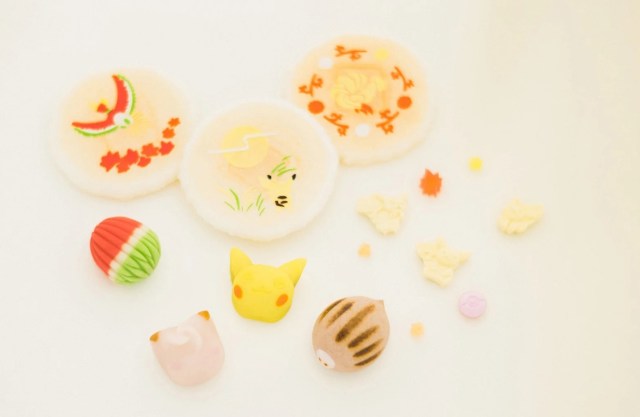
And yes, the Johto Legendary Pokémon is included.
With its first two video games coming out in 1996, and the anime premiering the very next year, Pokémon’s continuing and consistent popularity is something that most franchises can only dream about. That said, even Pokémon has a long way to go before it gets anywhere close to the current age of its latest creative partner, Shichijo Kanshundo.
Shichijo Kanshundo is a Kyoto confectioner that was founded in the first year of Japan’s Keio era, which converts to 1865. That means that when Shichijo Kanshundo sold its first sweets, Japan was still ruled by a shogun, and that shogun wasn’t even the last one.
Over 150 years later, Shichijo Kanshundo is still in business, making wagashi (Japanese sweets) the old-fashioned way. That doesn’t mean they’re averse to trying new things too, though, which brings us to these gorgeous and adorable Pokémon namagashi sweets.
Namagashi translates directly as “raw confectioneries,” and all of these have a soft, chewy texture. Pikachu and Ho-Oh are both nerikiri, made by kneading sweet white bean jam, gyuhi (rice flour dough) and grated yam together. Pikachu’s presence is always a given in any Pokémon collaboration, but Ho-Oh is here because it’s Kyoto’s representative Pocket Monster species, by virtue of the in-game Johto region, where Ho-Oh is found, being based on Kyoto.
Also part of the namagashi set is Swinub, taking the form of a joyo manju, a grated yam dumpling with bean paste inside. Like Ho-Oh, Swinub also hails from Johto, plus it resembles the illustrated boar shown amongst red leaves on Japan’s old-school hanafuda playing cards, making him an apt choice for this autumn namagashi-release. Finally, rounding out the set is Clefairy, who’s here as uiro, a type of sweet rice flour cake.
▼ All of the Pokémon namagashi are handmade, using water drawn in Kyoto’s Higashiyama area.
On the other hand, if you like your snacks savory instead of sweet, Shichijo Kanshundo is also preparing some Pokémon senbei rice crackers.
These come three to a set with either a male or female Pikachu, Ho-Oh, and Ninetales.
▼ Ninetales isn’t exclusive to the Johto region, but its design is clearly inspired by the fox spirits of Shinto folklore, such as the ones represented by countless statues at Kyoto’s Fushimi Inari Shrine.
And last, there’s the Pikachu Higashi.
Higashi literally means “dry confectioneries,” and these have a crunchier texture than the namagashi seen above. They’re made with wasanbon, a fine-grain sugar that traditional Japanese sweets makers and fans swear by, with Shichijo Kanshundo sourcing it from producers on the island of Shikoku, where the best wasanbon is said to come from. They even went to the trouble of making a special wooden mold for the Pikachu higashi, so that it can be cute and classically made.
As is often the case with Japanese sweets shops with a long history, Shichijo Kanshundo’s wares are generally meant to be given as gifts or enjoyed on special occasions. The four-piece namagashi set is priced at 2,916 yen (US$19.50), the three-piece senbei set at 1,728 yen, and the Pikachu higashi box at 2,160 yen.
All of the items will be available at Shichijo Kanshundo’s main shop in Kyoto’s Shichijo Neighborhood and at their Tokyo branch inside the Kita Senju Marui department store starting November 4. The senbei and higashi will also be for sale through the Shichijo Kanshundo online shop here from October 31, but the namagashi can only be purchased in-store, and only on the days of November 4 and 28. If a trip to Kyoto or Tokyo aren’t in the cards for you then, though, don’t despair, because Shichijo Kanshundo says this is only “the first round” of its team-up with Pokémon, so there should be more to come.
Related: Shichijo Kanshundo online store, location list
Source: PR Times, Shichijo Kanshundo
Top image: Shichijo Kanshundo
Insert images: PR Times, Shichijo Kanshundo
● Want to hear about SoraNews24’s latest articles as soon as they’re published? Follow us on Facebook and Twitter!

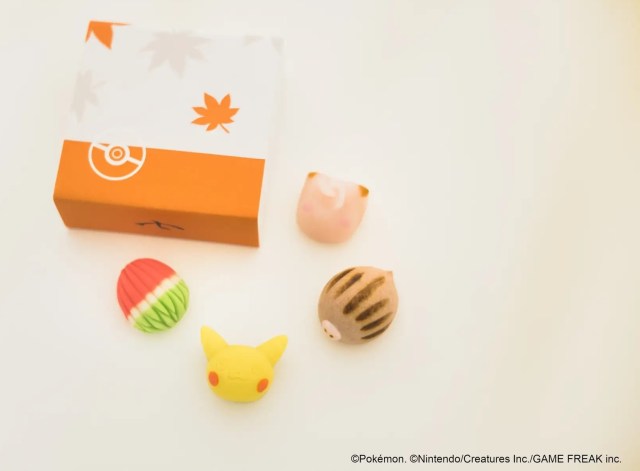
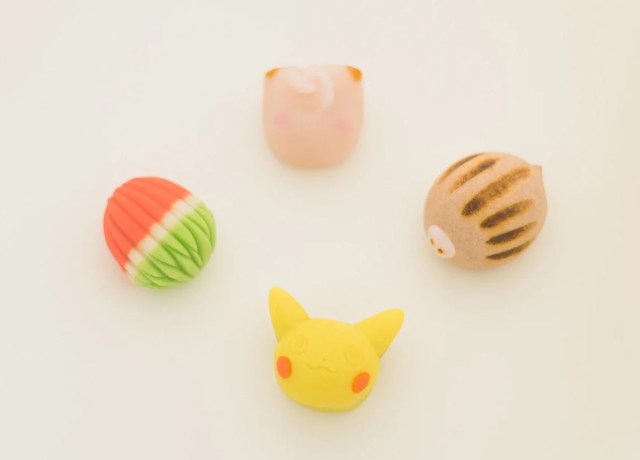
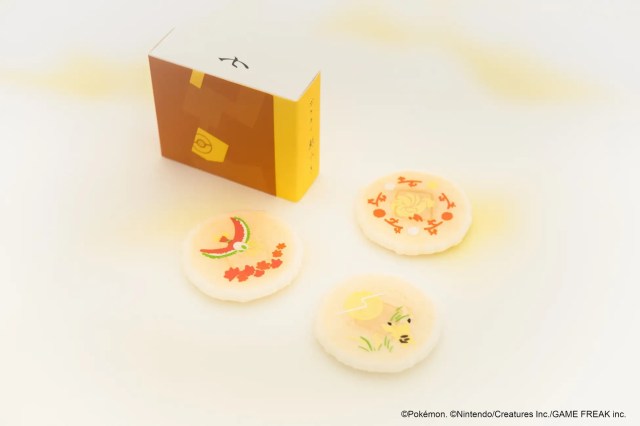
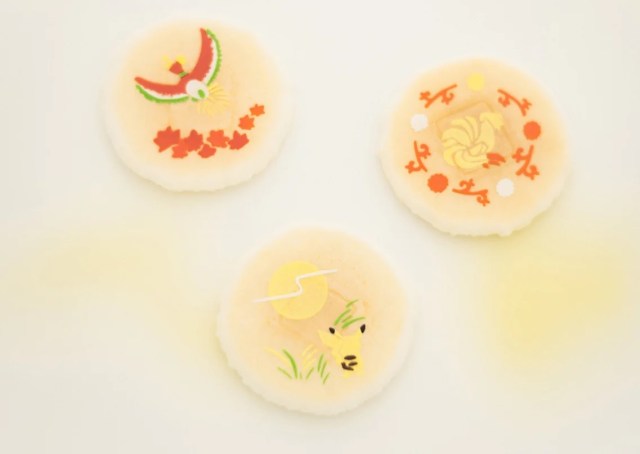
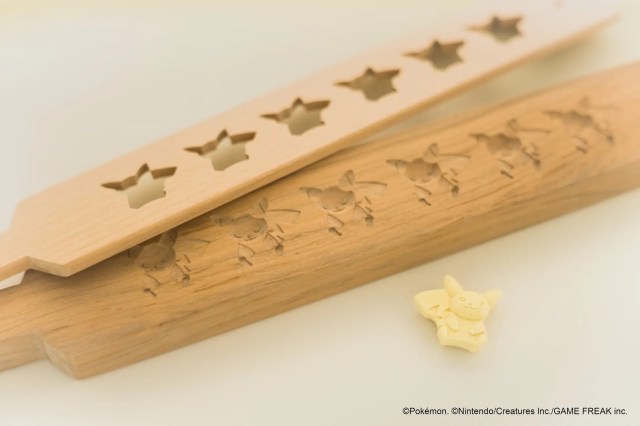

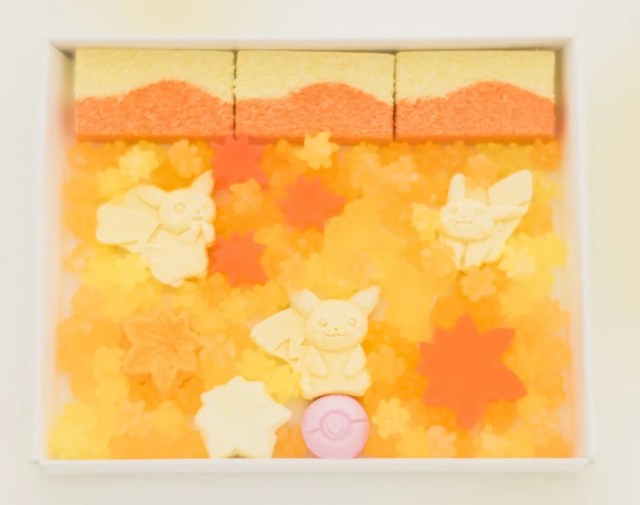
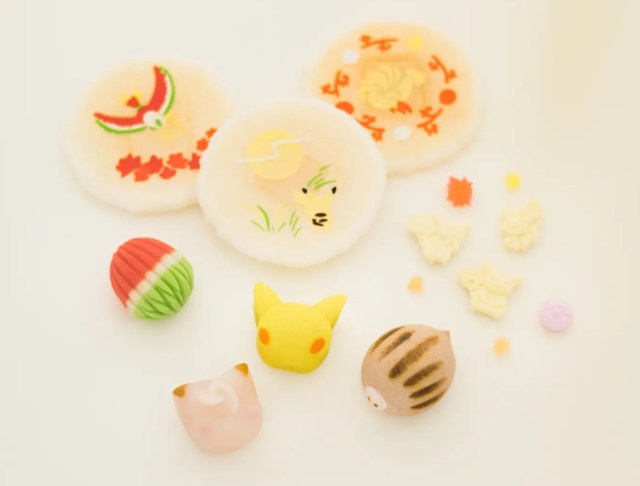
 More Pokémon wagashi confectionaries are coming from 159-year-old Japanese sweets maker
More Pokémon wagashi confectionaries are coming from 159-year-old Japanese sweets maker Celebrate the Tanabata star festival with beautiful Milky Way red bean gelatin
Celebrate the Tanabata star festival with beautiful Milky Way red bean gelatin We spend a morning with an expert wagashi chef creating no-bake traditional Japanese sweets!
We spend a morning with an expert wagashi chef creating no-bake traditional Japanese sweets! Kyoto now has Pokémon manhole covers as Generation 2 comes to the real-life Johto region
Kyoto now has Pokémon manhole covers as Generation 2 comes to the real-life Johto region Kyoto cafe with unfortunate name, gorgeous sandwiches keeps getting mistaken for e-commerce giant
Kyoto cafe with unfortunate name, gorgeous sandwiches keeps getting mistaken for e-commerce giant Seaside scenery, history, and so many desserts on Yokohama’s Akai Kutsu【Japan Loop Buses】
Seaside scenery, history, and so many desserts on Yokohama’s Akai Kutsu【Japan Loop Buses】 Sandwiches fit for a sumo served up in Osaka【Taste Test】
Sandwiches fit for a sumo served up in Osaka【Taste Test】 Foreigner’s request for help in Tokyo makes us sad for the state of society
Foreigner’s request for help in Tokyo makes us sad for the state of society Japanese ramen restaurants under pressure from new yen banknotes
Japanese ramen restaurants under pressure from new yen banknotes Japan’s summertime towelket pillowcases are even better with the addition of Ghibli stars【Photos】
Japan’s summertime towelket pillowcases are even better with the addition of Ghibli stars【Photos】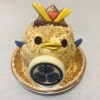 Samurai chick pudding cake is Japan’s newest hard-to-buy, delicious-to-eat treat【Taste test】
Samurai chick pudding cake is Japan’s newest hard-to-buy, delicious-to-eat treat【Taste test】 No talking allowed, at all, at new Tokyo cafe, even when you’re ordering【Videos】
No talking allowed, at all, at new Tokyo cafe, even when you’re ordering【Videos】 Mikado Coffee is a 76-year-old coffee chain with a major celebrity connection
Mikado Coffee is a 76-year-old coffee chain with a major celebrity connection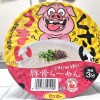 Does Japan’s “Stinky but Tasty” tonkotsu ramen live up to its name?
Does Japan’s “Stinky but Tasty” tonkotsu ramen live up to its name?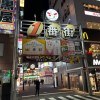 Stay at a Japanese capsule hotel in Tokyo for less than US$20 a night
Stay at a Japanese capsule hotel in Tokyo for less than US$20 a night McDonald’s new Happy Meals offer up cute and practical Sanrio lifestyle goods
McDonald’s new Happy Meals offer up cute and practical Sanrio lifestyle goods French Fries Bread in Tokyo’s Shibuya becomes a hit on social media
French Fries Bread in Tokyo’s Shibuya becomes a hit on social media Studio Ghibli releases new action figures featuring Nausicaä of the Valley of the Wind characters
Studio Ghibli releases new action figures featuring Nausicaä of the Valley of the Wind characters Red light district sushi restaurant in Tokyo shows us just how wrong we were about it
Red light district sushi restaurant in Tokyo shows us just how wrong we were about it New private rooms on Tokaido Shinkansen change the way we travel from Tokyo to Kyoto
New private rooms on Tokaido Shinkansen change the way we travel from Tokyo to Kyoto Tokyo Tsukiji fish market site to be redeveloped with 50,000-seat stadium, hotel, shopping center
Tokyo Tsukiji fish market site to be redeveloped with 50,000-seat stadium, hotel, shopping center Beautiful Ghibli sealing wax kits let you create accessories and elegant letter decorations【Pics】
Beautiful Ghibli sealing wax kits let you create accessories and elegant letter decorations【Pics】 Japanese city loses residents’ personal data, which was on paper being transported on a windy day
Japanese city loses residents’ personal data, which was on paper being transported on a windy day Studio Ghibli releases Kiki’s Delivery Service chocolate cake pouches in Japan
Studio Ghibli releases Kiki’s Delivery Service chocolate cake pouches in Japan New definition of “Japanese whiskey” goes into effect to prevent fakes from fooling overseas buyers
New definition of “Japanese whiskey” goes into effect to prevent fakes from fooling overseas buyers Our Japanese reporter visits Costco in the U.S., finds super American and very Japanese things
Our Japanese reporter visits Costco in the U.S., finds super American and very Japanese things All-you-can-drink Starbucks and amazing views part of Tokyo’s new 170 meter-high sky lounge
All-you-can-drink Starbucks and amazing views part of Tokyo’s new 170 meter-high sky lounge More foreign tourists than ever before in history visited Japan last month
More foreign tourists than ever before in history visited Japan last month New Pokémon cakes let you eat your way through Pikachu and all the Eevee evolutions
New Pokémon cakes let you eat your way through Pikachu and all the Eevee evolutions Disney princesses get official manga makeovers for Manga Princess Cafe opening in Tokyo
Disney princesses get official manga makeovers for Manga Princess Cafe opening in Tokyo Sales of Japan’s most convenient train ticket/shopping payment cards suspended indefinitely
Sales of Japan’s most convenient train ticket/shopping payment cards suspended indefinitely Sold-out Studio Ghibli desktop humidifiers are back so Totoro can help you through the dry season
Sold-out Studio Ghibli desktop humidifiers are back so Totoro can help you through the dry season Japanese government to make first change to romanization spelling rules since the 1950s
Japanese government to make first change to romanization spelling rules since the 1950s Ghibli founders Toshio Suzuki and Hayao Miyazaki contribute to Japanese whisky Totoro label design
Ghibli founders Toshio Suzuki and Hayao Miyazaki contribute to Japanese whisky Totoro label design Doraemon found buried at sea as scene from 1993 anime becomes real life【Photos】
Doraemon found buried at sea as scene from 1993 anime becomes real life【Photos】 Tokyo’s most famous Starbucks is closed
Tokyo’s most famous Starbucks is closed One Piece characters’ nationalities revealed, but fans have mixed opinions
One Piece characters’ nationalities revealed, but fans have mixed opinions We asked a Uniqlo employee what four things we should buy and their suggestions didn’t disappoint
We asked a Uniqlo employee what four things we should buy and their suggestions didn’t disappoint Princesses, fruits, and blacksmiths: Study reveals the 30 most unusual family names in Japan
Princesses, fruits, and blacksmiths: Study reveals the 30 most unusual family names in Japan Japan’s matcha green tea beer satisfies two cravings in an awesomely delicious way
Japan’s matcha green tea beer satisfies two cravings in an awesomely delicious way Pokémon Centers around Japan celebrate the opening of Kyoto branch with commemorative goods
Pokémon Centers around Japan celebrate the opening of Kyoto branch with commemorative goods Nintendo’s historic former headquarters in Kyoto to reopen as a hotel
Nintendo’s historic former headquarters in Kyoto to reopen as a hotel Pikachu and Kyoto candy maker team up for confectionary collaboration centuries in the making
Pikachu and Kyoto candy maker team up for confectionary collaboration centuries in the making Ho-Oh and Lugia desserts to descend on the Pokémon Cafe in Tokyo
Ho-Oh and Lugia desserts to descend on the Pokémon Cafe in Tokyo Pokémon come to real-life Johto region with new Pokémon manhole covers for Nara【Pics】
Pokémon come to real-life Johto region with new Pokémon manhole covers for Nara【Pics】 Pokémon teams up with eyewear company JINS for 59 new stylish glasses for adults and kids
Pokémon teams up with eyewear company JINS for 59 new stylish glasses for adults and kids Kyoto’s newest Shinkansen souvenir: Canned cakes filled with matcha and cherry blossoms
Kyoto’s newest Shinkansen souvenir: Canned cakes filled with matcha and cherry blossoms New Tokyo Pokémon Cafe Johto menu items require knowledge of Pokémon lore to order them【Photos】
New Tokyo Pokémon Cafe Johto menu items require knowledge of Pokémon lore to order them【Photos】 Pikachu is opening his own take-out Pokémon sweets shop in Tokyo!
Pikachu is opening his own take-out Pokémon sweets shop in Tokyo! Pikachu’s butt evolves into delicious dessert at Tokyo’s official Pokémon sweets shop
Pikachu’s butt evolves into delicious dessert at Tokyo’s official Pokémon sweets shop Watch out … Here come more electrifyingly cute treats from Pikachu Sweets by Pokémon Cafe!
Watch out … Here come more electrifyingly cute treats from Pikachu Sweets by Pokémon Cafe! Pokémon GO game adds Sableye, Banette, more Hoenn Pokémon
Pokémon GO game adds Sableye, Banette, more Hoenn Pokémon Pokémon Gold and Silver Pocket Monsters finally added to Pokémon GO!
Pokémon Gold and Silver Pocket Monsters finally added to Pokémon GO! Pokémon Pinap Berry Juice being served in real world at Tokyo’s Pikachu Sweets cafe【Taste test】
Pokémon Pinap Berry Juice being served in real world at Tokyo’s Pikachu Sweets cafe【Taste test】
Leave a Reply